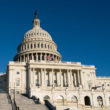The U.S. economy grew at a slower rate in the first quarter of 2023, with the gross domestic product increasing at a rate 1.1 percent.
The growth estimate released Thursday by the Bureau of Economic Analysis was a step back from the 2.6 percent recorded in the fourth quarter of 2022.
The GDP is the value of the goods and services produced by the nation’s economy less the value of the goods and services used up in production.
The BEA said the deceleration was “primarily reflected a downturn in private inventory investment and a slowdown in nonresidential fixed investment.”
But consumer spending kept the economy growing, according to the BEA. Spending grew at a 3.7 percent annual rate, as pointed out in an analysis by the New York Times.
“The increase in consumer spending reflected increases in both goods and services. Within goods, the leading contributor was motor vehicles and parts. Within services, the increase was led by health care and food services and accommodations,” the BEA reported.
Current-dollar personal income increased $278.9 billion, compared with an increase of $398.8 billion in the fourth quarter. Disposable income also increase 12.5 percent to $571.2 billion. a spike from the $403 billion or 8.9 percent in the final quarter of 2022.
The BEA shows a big jump in used auto purchase in the first quarter of 2023, with the annual rate increasing along with the net transaction and margin.











